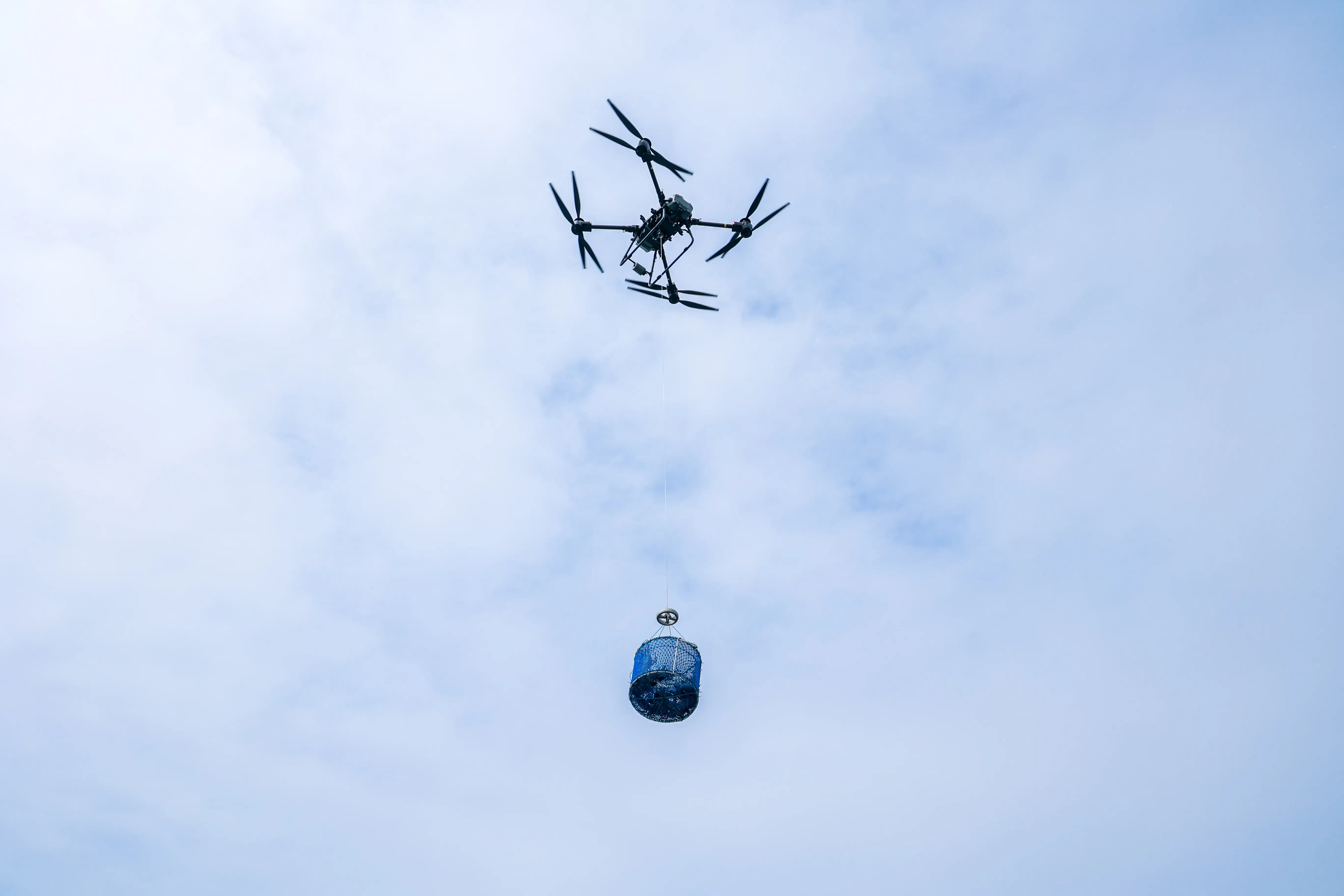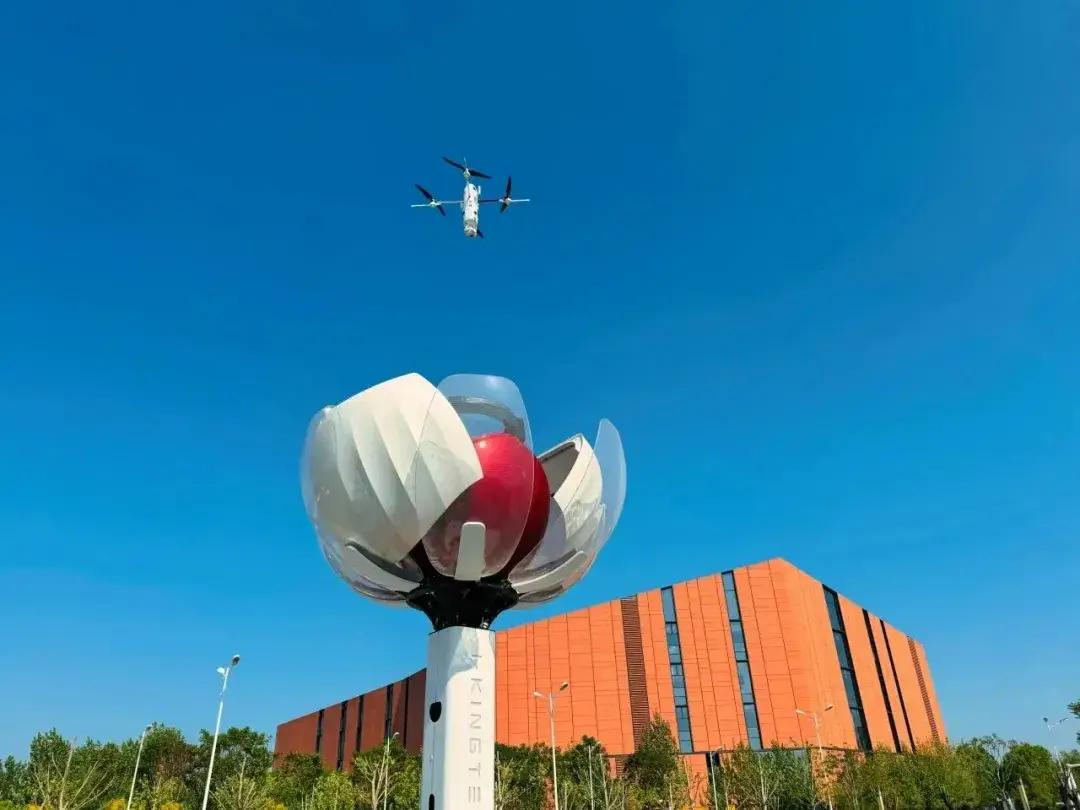
The heavy and fragrant ears turn golden, filling the walls with a bountiful harvest. During the autumn harvest and planting season, agricultural drones are once again of great help. Currently, the development of the low altitude economy, marked by the application of drones, is booming and has broad prospects, becoming a new race track to be pursued.
As a typical representative of new quality productive forces, low altitude economy was first included in the government work report this year, and the Third Plenary Session of the 20th Central Committee of the Communist Party of China specifically mentioned the development of low altitude economy. Riding on the wave of 'busy autumn days', the reporter walked through the fields to explore the possibilities of low altitude economy in the agricultural sector.
The sky above the farmland is a bit busy
On November 16th, in Zhujiabian Village, Baima Town, Lishui District, Nanjing City, Wang Yonglun, the head of Yonglun Agricultural Machinery Professional Cooperative, led workers to operate a large Xinjiang T30 agricultural crop protection drone on the field ridge, modeling and starting the program. With the rotation of the fan, a drone flew into the air to sow fine base fertilizer for the newly planted wheat seeds below. He told reporters that after purchasing drones in 2021, the efficiency is higher and people are more relaxed. The cooperative has over 500 acres of land. Previously, manual spraying required at least 4-5 people to work for 10 days, but now it only takes one person to operate for one day
The use of drones for crop protection has become very common in field operations. This summer, with consecutive high temperatures, rice and corn in Jianhu County have entered a critical grain filling period, while soybeans have entered a grain filling period. The county's Agriculture and Rural Bureau has invited Dragonfly Agricultural Clothing, a subsidiary of Kesheng Group, to implement a "one spray, multiple promotion" autumn grain project (one operation can achieve multiple effects such as promoting growth and development, promoting grain maturity, and increasing yield). This time, more than 60 crop protection drones were mobilized to form a dragonfly service team of over 80 people, providing a 4-day social service for 180000 mu of autumn crops in the county, minimizing losses caused by high temperature disasters. Recently, during the autumn harvest, the autumn grain crops in Jianhu have achieved stable and increased yields, especially with an average increase of over 50 kilograms per mu in rice production. In high temperature weather, large-scale crop operations rely heavily on manual labor to catch up with the progress, and drones have played a significant role, "said Zheng Jiesong, a technology special envoy of Dragonfly Agricultural Service who has been rooted in the fields all year round.
On the water surface, drones can assist shrimp and crab farmers in feeding and feeding. Li Ziqiang, Executive Vice President of the Suzhou Yangcheng Lake Hairy Crab Industry Association and Chairman of Suzhou Huqiang Agricultural Technology Co., Ltd., currently has 422 acres of high standard crab ponds and 160 acres of crab farming in the Yangcheng Lake area. In 2022, he purchased a large Xinjiang drone for feeding and described it as hiring a non tiring worker for the crab pond. Previously, we had to manually row boats to the surface and then feed, which required six or seven people to feed for three hours on over 400 acres of water. Now, drones only require one person to work for two hours. Moreover, crabs mainly grow in summer, which saves them from high temperatures and sun exposure, "said Li Ziqiang.
Changing the scene to hilly and mountainous areas, drones can also act as "delivery guys". In mid May, some growers in Suzhou attempted to use Fengyi Technology's unmanned aerial vehicle "Ark 40" to transport harvested loquats from the mountains to harvesting points, ensuring the freshness and high quality of loquats. This is the exploration of low altitude aircraft serving daily life scenarios in Wuzhong District. In addition, the real-time response up and down the mountain has accelerated and increased the efficiency of half day delivery of loquat in the same city and across cities, achieving the fastest delivery time of 6 hours to Jiangsu, Zhejiang, and Shanghai, and delivery within 48 hours to 259 cities in China.
Agricultural drones, professionally referred to as agricultural unmanned aerial vehicles. Data shows that Jiangsu is a major province for agricultural machinery manufacturing and use, with a total ownership of 23400 agricultural unmanned aerial vehicles, ranking first in the country and accounting for a high proportion of 14.4%. Zhou Zhongcheng, Deputy Director of the Agricultural Machinery Equipment Department of the Provincial Department of Agriculture and Rural Affairs, introduced that since 2009, farmers in Jiangsu have started using unmanned plant protection machines. At present, the main and most important manifestation of low altitude economy in the agricultural field of Jiangsu is in plant protection, and it is also applied in the feeding of freshwater aquaculture and transportation in hilly and mountainous areas. Especially during the critical period of wheat Fusarium head blight prevention and control in the province from April to May this spring, a total of 6.0845 million agricultural drones connected to the "Jihuilai" platform operated, covering an area of 42.6334 million acres. They won the battle of Fusarium head blight prevention and control with high quality, winning the battle of "seizing grain from insect mouths" and disaster resistance to harvest. Agricultural drones are efficient, precise, and flexible, not only improving the efficiency and effectiveness of pest and disease control, but also ensuring food security, achieving drug reduction and safety, promoting cost savings and income increase, and bringing significant economic and social benefits to agricultural production, "he said.
The radiation industry is poised to take off
Low altitude economy, in short, is' low altitude aircraft flying in the sky '. This sentence covers a lot of content:' low altitude 'mainly refers to the low altitude' airspace 'below 300 meters, which is the key resource for the development of low altitude economy;' flying 'is behavior, the main activity of low altitude economy, and' aircraft 'is equipment, involving upstream and downstream industrial chains such as manufacturing and supporting. The so-called low altitude economy is a comprehensive economic form dominated by the low altitude flight activities of manned and unmanned aerial vehicles, triggering and radiating the integration and development of related fields. Economy must be reflected in the industrial form. "Experts in the field of low altitude economy in the province analyze that low altitude economy includes the low altitude manufacturing industry composed of materials, manufacturing, research and development, etc., and is composed of roads. River and cable testing, construction monitoring The low altitude aviation industry, consisting of urban transportation and other components, the low altitude comprehensive industry, consisting of finance, insurance, operational training, air exhibitions, etc., and the low altitude support industry, consisting of providing communication, meteorology, air navigation, flight surveillance, as well as flight camps, charging and refueling, and take-off and landing points, together constitute the four major industrial sectors of the low altitude economy.
He introduced the main content of the "Interim Regulations on the Management of Unmanned Aerial Vehicle Flights" that came into effect on January 1st this year, emphasizing that this regulation provides strong support for the development of low altitude economy. According to regulations, low altitude flight activities must be approved and reported within the controlled airspace, and can fly freely below a true altitude of 120 meters within the suitable flight airspace. Agricultural drones are mainly used for agricultural crop protection at ultra-low altitudes and do not require approval and reporting. The operation certificate only requires them to follow the equipment usage requirements and undergo training in the use of agricultural machinery to be able to use them safely and proficiently. The regulations have specific and lenient requirements for the flight and operation of agricultural crop protection drones. The airspace is vertically divided into A, B, C, D, and E controlled airspace and G and W uncontrolled airspace. "The airspace resources used for low altitude economy are mainly G and W
There are usually five types of drone models: micro drones weighing 250g or less (which many consumers purchase for aerial photography), light drones weighing 4kg to 7kg, which do not require an operating certificate to fly below a true height of 120 meters in the suitable airspace, small drones weighing 15kg to 25kg, medium drones weighing 25kg to 150kg, and large drones weighing over 150kg. Experts have introduced that various types of drones are used in the agricultural field. Micro drones can be used for inspecting soil moisture and crop growth in farmland. Light and small drones can carry crop analysis equipment, sound amplification bird drive equipment, etc. for field management. Medium sized drones are used for precise seed package sowing, pesticide spraying, and other field plant protection tasks.
On November 12th, the reporter arrived at the production workshop of Tuo Gong (Nanjing) Robot Co., Ltd. Over a hundred drones of various sizes were arranged in a dark and orderly manner, while workers on the right were busy and orderly carrying out assembly operations. On the nearby job supervision platform, effective flight data from various places is being refreshed in real time. At 10 o'clock that day, the large screen displayed 150 online aircraft with a total flight volume of over 4 million. Co founder and General Manager Zhang Yu told reporters that the company was founded in 2015, initially specializing in drone flight control systems. In 2019, it began producing complete machines, with agricultural drones being the earliest complete machine product line and crop protection drones being the core research and development product line. At present, the company has successfully launched a series of multi rotor crop protection unmanned aerial vehicles such as TG26 and Fengpeng 600 in the field of agricultural crop protection. They are not only sold throughout the country, but also exported to Southeast Asia, Japan, South Korea, Europe, America, and South America. In 2023, the company's revenue will exceed 100 million yuan and maintain an annual growth rate of over 20%.
At the exhibition hall of Tuo Gong, the reporter saw various crop protection drones developed since the establishment of the enterprise. The latest Fengpeng 600 is equipped with a 50L spray box, and the wind pressure four centrifugal nozzle makes the spraying more fine and uniform, with a flow rate of up to 20L/min. The "3D+AI" mode makes the machine more suitable for complex environments such as orchards and hills.
Zhang Yu said that the country attaches great importance to storing grain through technology, and intelligent agricultural machinery and equipment belong to "technology". At the beginning of his entrepreneurship, he focused on agricultural drones, firstly because he graduated from the Department of Electronic Engineering at Nanjing University and could produce drone application products, and secondly because he was aware of the booming market demand in the agricultural field. At present, there is a research and development team of 110 people, all of whom come from well-known aviation universities such as Beihang and China Southern Airlines, and have extensive cooperation with scientific research institutions such as the Nanjing Agricultural Mechanization Research Institute of the Ministry of Agriculture and Rural Affairs and Nanjing University. The current industry reshuffle has been basically completed, but our pursuit of products and research and development innovation will not stop. We will also try new models and application scenarios in commercial exploration. Our product managers and distributors maintain close contact with customers, keep a close eye on new needs in real time, in order to launch new products. The new generation of Fengpeng 700 crop protection unmanned aerial vehicle with superior performance is about to be launched, "he said.
Extending and supplementing the chain will yield benefits
According to estimates, the scale of China's low altitude economy is expected to exceed 500 billion yuan by 2023 and 2 trillion yuan by 2030. Under the considerable economic benefits, the widespread application of drones in the agricultural field has also exposed some urgent problems that need to be solved.
For example, the endurance, operating cost, and user experience of drones. Li Ziqiang mentioned that the drones currently in use can only fly for 15 minutes when fully charged, which is only half of the time when they were first purchased two years ago. Furthermore, the high cost of insurance restricts some people's ability to purchase. I bought a drone, and the insurance for the first year was included as a gift. In the second year, it costs about three to five thousand yuan, which is similar to car insurance. Farming itself is high-risk, and many farmers choose not to 'farm it'. Also, drones are often updated and iterated, and if new models are released, the backend maintenance for the old models is not as strong as before. For example, old software may not be very user-friendly, and parts may not be replaced in a timely manner if they break down
An employee of a drone manufacturing company told reporters that new and old issues have become the norm in the industry. Although drones are a new type of agricultural machinery, they are essentially electronic products, just like smartphones and new energy vehicles. With rapid updates, the level of backend maintenance for old versions is not as strong as before, "he analyzed.
For example, due to the expansion of the application scope of agricultural drones, the number of drones is gradually increasing, which also puts forward new requirements for grassroots maintenance systems and maintenance capabilities. As of now, the number of unmanned aerial vehicles in Suzhou is over 800. The person in charge of Suzhou Agricultural Machinery Technology Promotion Station said that in order to attract more young talents willing to engage in agricultural drone maintenance, Suzhou Agricultural Machinery Technology Promotion Station is currently cooperating with vocational colleges that offer low altitude economy related majors to create a low altitude economy maintenance talent training base.
Experts suggest that the four major sectors involved in the low altitude economy have a long industrial chain and strong driving force. Relevant laws and regulations should be formulated and improved in a timely manner, and policies should be strengthened to ensure supply; Local governments should timely release policies related to low altitude flight service standards, encourage and support low altitude industry enterprises, and safeguard the high-quality development of low altitude economy. In the development of low altitude economy industry, private enterprises such as DJI unmanned aerial vehicles have accumulated unique advantages in research and development, manufacturing, sales, import and export of low altitude manufacturing for more than ten years. Low altitude flight has come to the forefront, guided by the government and sung by private enterprises. Provincial and local state-owned enterprises should strengthen investment in the service and support infrastructure of low altitude airspace, accelerate the research and determination of the development model of low altitude support industry, promote the rapid formation of the low altitude economic industry ecology, resonate with each other, and create a strategic emerging industry of low altitude economy.
At present, the data standards of various agricultural drone enterprises are not consistent, and the data is incompatible with each other, which restricts the construction and application of big data platforms and databases. Digital intelligent management needs to be further strengthened. At the same time, there is still a shortage of relevant talents, which is mainly manifested in the overall shortage, insufficient technical training, and inadequate standardized operation, which to some extent restricts the promotion and application of relevant technologies. Zhou Zhongcheng said that in the next step, Jiangsu will fully play the role of agricultural machinery purchase and application subsidy policies, comprehensively carry out agricultural drone purchase subsidy work, and meet the needs of agricultural production. Strengthen communication with manufacturing enterprises to enhance equipment management. Guide drone system producers to standardize training and assessment content, and enhance users' flight defense skills. In addition, daily supervision will be strengthened, with a focus on safety supervision.




